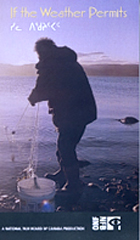
If the Weather Permits 2003
Distributed by National Film Board of Canada, 1123 Broadway, Suite 307, New York, NY 10010; 800-542-2164
Produced by Yves Bisaillon
Directed by Elisapie Isaac
VHS, color, 28 min.
Adult
Native American Studies, Area Studies, Canadian Studies, Multicultural Studies, Social Studies
Date Entered: 03/03/2005
Reviewed by Karen MacArthur, Kansas State UniversityPresented as a letter to a grandparent, this documentary questioning the place and future of Inuit culture affords viewers a dissatisfying peek at issues the tribe faces after dramatic changes to its traditional lifestyle occurred in the twentieth century. The questions asked in this film are the same questions all cultures face: how to preserve heritage? How do we fit in the modern world? Unfortunately for this film, the responses given are not well thought out and not especially interesting. When asked how he will preserve his Inuit heritage, one interviewee laughs, “I will keep canoeing.”
Throughout the film tantalizing bits of Inuit history are mentioned but never developed. For example, one interviewee discusses the great loss the Inuit experienced when their sled dogs were killed and the narrator later states, “in many villages men are hired to kill them” but we aren’t told who is hiring these men or why. Another referral is to the “gifts of the white man,” which presumably means technology, but is never mentioned again. Little history of the Inuit is presented at all; most of the film is contemporary interviews with an elderly man reminiscing about hunting techniques and weather patterns and with young men answering the narrator’s questions about ancestors. Footage of hunting from prior documentaries is interwoven with current material.
Additional materials will be necessary to understand the significance of the sled dogs and the powerful effect their loss had upon the tribe. Although the interviewee states that the dogs were useful in finding the way home in a blizzard, the full understanding of the tribe’s nomadic nature and dependence upon the dogs’ special abilities - sniffing seal air holes, pulling substantial weights with minimal food, listening for polar bears - is not developed to the level audiences unfamiliar with the tribe might require.
The film employs lengthy shots of the narrator and various individuals staring seriously at the camera - time that might have been better spent on footage of the landscape, tribal properties, artwork, anything that might show something meaningful about the Inuit. Color and sound are excellent. Interviews and narration are spoken in English and Inuktitut with English subtitles. Audiences of high school age and above will find this documentary understandable and it is suitable for both public and academic libraries with the appropriate additional information. Much of the information provided in this documentary and the questions regarding assimilation are covered in other sources; the style of presentation as a visual letter to a grandparent is what makes it unique. The film is not recommended because it is more artistic than educational and because of its reliance on supplementary material.
Awards
- Rigoberta Menchu Tum Grand Prize at the First People’s Film Festival
- 1st Indian Summer Festivals Film & Video Image Awards for Documentary Short